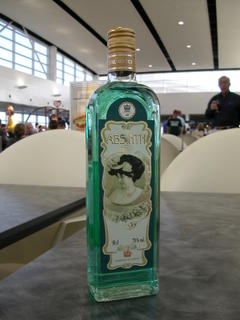The Lost Generation

I stole this history from the absinthebuyersguide.com Me I bought the stuff cause I liked the bottle. I had a couple of drinks and decided bad hangover was one quality not mentioned in the below history. I took the bottle to a Christmas party and they also had a jar of moonshine. ( I drank beer) I was appalled that they did not pay attention to the ritual in drinking this rare drink, they just passed it among one another with the shine. I left in a huff as you can well imagine. So I dont know if it has narcotic quality's but I have a buddy that had four stiff drinks of the stuff and he said he felt funny but remember its strong, almost as strong as moon shine. Absinthe was the drink of choice among artist and writers in the mid to late19th century. It inspired poets and appeared in works by Pablo Picasso (left) and Vincent Van Gogh (right). It was drank by the scandalous playwright Oscar Wilde, the eccentric Toulouse-Lautrec, the poets Charles Baudelaire and Edgar Allen Poe, and the famous 20th century author Ernest Hemingway, just to mention a few. By the end of the 19th century, grape phylloxera had destroyed two-thirds of the vineyards on the continent of Europe. The price of wine skyrocketed and was soon in short supply. The Aristocrats bought and consumed what was available, leaving the middle-class "la bourgeoisie" of artisans and tradesmen searching for a cheaper alternative. Absinthe was already growing in popularity and was a perfect alternative, being a distilled spirit, it was much stronger than wine and had a mysterious effect that heightened the senses. It was perfect for the emerging Bohemian culture growing in Europe. In the cafés of Paris, the cocktail hour bacame known as "L'Heure Verte", the Green Hour. According to history, or perhaps myth, the elixir of wormwood was orginally developed by Dr. Pierre Ordinaire in 1789. He was a French doctor who was living in the Suisse town of Couvet, in the Canton of Neuchâtel. The doctor was in self-exile due to political reasons from the Franche-Comté region. It was said that he discovered the plant wormwood (Artemisia Absinthium) while traveling in the Val-de-Travers. He mixed wormwood and other herbs with alcohol to create his 136 proof elixir, which he employed in his treatment of the sick and retched. After many claims of miraculous healing powers, it became a panacea or cure-all. It was eventually nicknamed, "la Fée Verte", which means the Green Fairy. It was believed that Dr.Ordinaire bequeathed his recipe to Mademoiselle Grand-Pierre, who supposedly sold it to two sisters named Henroid in Couvet. However, historical information suggest that the Henroid sisters were making the distilled elixir before the Doctor arrived in the area. The doctor is credited with being one of the first to promote la Fée Verte. The Henroid sisters exploited the elixir commercially. They offered samples of the elixir to be sold in nearby pharmacies. In 1797, they sold their recipe to a Frenchman named Major Dubied. In that same year, the Major's daughter "Emilie" married Henri-Louis Pernod. The Major, his son Marcellin, and Pernod built the first commercial absinthe distillery in Couvet under the name of "Dubied Père et Fils". In 1805 Pernod opened a larger factory across the border on the main street in Pontarlier France under the corporate name of "Maison Pernod Fils". One of the reasons for the move was to avoid the high import taxes at the French border. The main street facility operated two stills producing approximately 16 liters of absinthe per day. As popularity grew, Pernods youngest son, "Louis" purchased 36,000 square meters of land on the banks of Doubs River to build a second factory. The second factory produced more than 400 liters of absinthe per day. By the mid 1850s, the plant had grown to produce 20,000 liters per day. At the height of production, they produced 30,000 liters per day and distributed absinthe to many ports around the world.
| |||||||||||||||||||||||||||||||


0 Comments:
Post a Comment
Subscribe to Post Comments [Atom]
<< Home